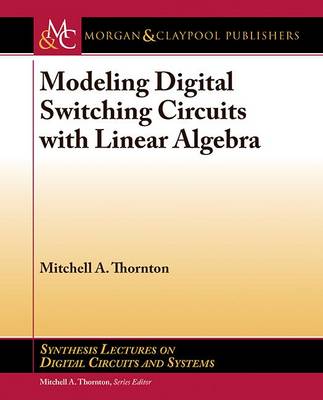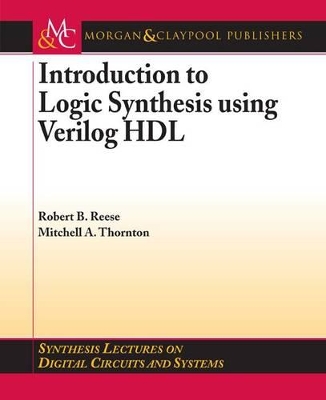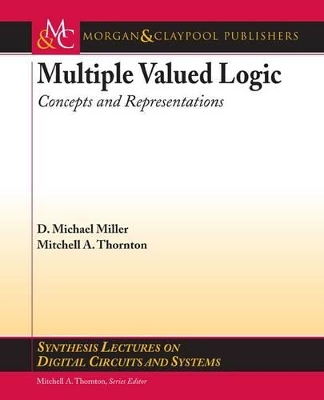Synthesis Lectures on Digital Circuits and Systems
3 total works
Modeling Digital Switching Circuits with Linear Algebra
by Mitchell A Thornton
Published 1 April 2014
Modeling Digital Switching Circuits with Linear Algebra describes an approach for modeling digital information and circuitry that is an alternative to Boolean algebra. While the Boolean algebraic model has been wildly successful and is responsible for many advances in modern information technology, the approach described in this book offers new insight and different ways of solving problems. Modeling the bit as a vector instead of a scalar value in the set {0, 1} allows digital circuits to be characterized with transfer functions in the form of a linear transformation matrix. The use of transfer functions is ubiquitous in many areas of engineering and their rich background in linear systems theory and signal processing is easily applied to digital switching circuits with this model. The common tasks of circuit simulation and justification are specific examples of the application of the linear algebraic model and are described in detail. The advantages offered by the new model as compared to traditional methods are emphasized throughout the book. Furthermore, the new approach is easily generalized to other types of information processing circuits such as those based upon multiple-valued or quantum logic; thus providing a unifying mathematical framework common to each of these areas.
Modeling Digital Switching Circuits with Linear Algebra provides a blend of theoretical concepts and practical issues involved in implementing the method for circuit design tasks. Data structures are described and are shown to not require any more resources for representing the underlying matrices and vectors than those currently used in modern electronic design automation (EDA) tools based on the Boolean model. Algorithms are described that perform simulation, justification, and other common EDA tasks in an efficient manner that are competitive with conventional design tools. The linear algebraic model can be used to implement common EDA tasks directly upon a structural netlist thus avoiding the intermediate step of transforming a circuit description into a representation of a set of switching functions as is commonly the case when conventional Boolean techniques are used. Implementation results are provided that empirically demonstrate the practicality of the linear algebraic model.
Modeling Digital Switching Circuits with Linear Algebra provides a blend of theoretical concepts and practical issues involved in implementing the method for circuit design tasks. Data structures are described and are shown to not require any more resources for representing the underlying matrices and vectors than those currently used in modern electronic design automation (EDA) tools based on the Boolean model. Algorithms are described that perform simulation, justification, and other common EDA tasks in an efficient manner that are competitive with conventional design tools. The linear algebraic model can be used to implement common EDA tasks directly upon a structural netlist thus avoiding the intermediate step of transforming a circuit description into a representation of a set of switching functions as is commonly the case when conventional Boolean techniques are used. Implementation results are provided that empirically demonstrate the practicality of the linear algebraic model.
Introduction to Logic Synthesis Using Verilog Hdl
by Robert B Reese and Mitchell A Thornton
Published 28 June 1905
Introduction to Logic Synthesis Using Verilog HDL explains how to write accurate Verilog descriptions of digital systems that can be synthesized into digital system netlists with desirable characteristics. The book contains numerous Verilog examples that begin with simple combinational networks and progress to synchronous sequential logic systems. Common pitfalls in the development of synthesizable Verilog HDL are also discussed along with methods for avoiding them. The target audience is anyone with a basic understanding of digital logic principles who wishes to learn how to model digital systems in the Verilog HDL in a manner that also allows for automatic synthesis. A wide range of readers, from hobbyists and undergraduate students to seasoned professionals, will find this a compelling and approachable work. The book provides concise coverage of the material and includes many examples, enabling readers to quickly generate high-quality synthesizable Verilog models.
Multiple Valued Logic: Concepts and Representations begins with a survey of the use ofmultiple-valued logic in several modern application areas including electronic design automation algorithms and circuit design. The mathematical basis and concepts of various algebras and systems of multiple valued logic are provided including comparisons among various systems and examples of their application. The book also provides an examination of alternative representations of multiple-valued logic suitable for implementation as data structures in automated computer applications. Decision diagram structures for multiple valued applications are described in detail with particular emphasis on the recently developed quantum multiple valued decision diagram.


